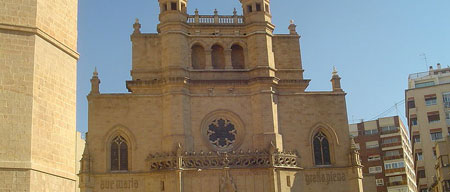Home > Study in Spain > City Guide > Castellón
Castellón City Guide
- Places of Interest
- Maps
- Getting to
- Getting around the city
Located in the Valencian Community, in the east of the Iberian Peninsula, on the Costa del Azahar by the Mediterranean Sea, lies the authentic capital city of the province of Castellón, Castellón de la Plana. This city is able to sustain its provincial charm and traditions yet provide classic modernity to all those who come to visit as a result of all the city's urban development programmes. With a number of historical sites and monuments and a true variety of museums, the city can offer more modern and relaxing alternatives to whatever you are looking for also. There are three beautiful sandy beaches with a number of amenities and recreational activities on offer, and also a large host of beautiful parks bursting with aromatic flowers and generous greenery. Even though Castellón is not necessarily one of the larger Spanish cities, it certainly does not fail to disappoint in terms of what it has to offer to all that come to visit.
Places of Interest
The Procathedral of Saint Mary
Constructed in the 12th century, this is the largest concathedral and only three entrances of the original gothic church remain in addition to some ornamental elements. The main entrance retains a gothic style yet the inside has baroque themes and a stunning image of the Virgin Mary from the 18th century as well as various interesting paintings and several works of gold.
The City Hall
Built at the beginning of the 18th century replacing the previous palace, Palau de la Vila, this building is comprised of three storeys. It has a Tuscan façade and a beautiful marble staircase providing access to the different rooms. Balconies make up the second floor and windows make up the third. In the Council Chambers can be found sculptures, paintings and frescoes from the 19th and 20th centuries.
El Fadrí
The construction of this bell tower began in 1440 and it is located in the Plaza Mayor in the centre of the city. With a beautiful octagonal shape and height of 60 metres, it is divided into 4 sections and the top is decorated with eight gargoyles. On the top of the tower spire from 1735 which is a replica from the original which was destroyed in 1656. The inside of the tower hosts a stunning spiral staircase which allows access to the different floors of the tower. El Fadrí is a significant piece of national heritage and a visit here should definitely be made!
The Hemp Exchange Market
Or La Lonja as it is more affectionately known comprises several floors and was built in the early 17th century. The building has gone through several centuries of different ownership and change however today it has an eclectic character and classic style and now takes the form of a bourgeois home. La Lonja was declared a historic and artistic landmark in 1984 and since the late 90s; the university has been recovering the building as a centre for educational and cultural development but are maintaining to recover the accumulation of styles that the market has seen through the years.
Bullring
The city's boasts a large and beautiful bullring inaugurated near the end of the 19th century. Bulls were once fought there by the "kings" of bullfighting and at the time it was always a full house and Castellón was a great bullfighting capital. Inside, for the main façade, is a bronze medallion with a bull head inside made by the same sculptor who made the statue of King James for the city of Castellón, José Viciano Martí. As places like this are of great traditional value to the Spaniards, this should definitely be visited during your stay.
Planetarium
Castellón's planetarium is one of the first buildings of this architectural type constructed in Valencia and offers the public a diverse and varied view of science from nature to physics. There are a host of outdoor exhibitions, a projection room, three galleries and the Planetarium room which has a Carl Zeiss projector. This proves to be a highly educational and interesting visit and applies to people of all ages therefore perfect for families!
Parque Ribalta
This is by far Castellón's most symbolic garden and one of the most unique in the Valencian community. It boasts more than 450 species all displaying great botanical richness and diversity. The park was built on top of the old Calvario cemetery at the end of the 19th century when the city began to move towards industrialisation. There are several areas decorated with tiles and also a group of benches decorated as such dated from the 1920s. The place has been listed a national heritage site and is an ideal place to relax and release thoughts.
Beaches
Castellón has 3 beaches: Playa del Pinar, Playa del Gurugú and Playa del Serradal. Across the 3, the town can offer parking spots, green spaces, a coastal park, showers, sports areas, recreational zones for children and golden sand. They are all diverse and incredibly beautiful and each is near city attractions of its own. The beaches provide an easy escape from walking through the streets and visiting museums and allow for you to kick-back, relax and enjoy the Spanish weather.
Museums
Fine Arts Museum
With a fine art collection comprising collections initially forming part of the Provincial Museum of Castellón, the art collection from the Provincial Delegation of Castellón, el Prado and various other donations, there are a large range of pieces to be admired. If you are looking for some authentic Spanish culture but fancy it in the form of something more peaceful, then this museum is an ideal stop.
Museum of Military History
Located in the old barracks of the Infantry Regiment, this museum is comprised of two storeys and is surrounded by an enclosed area where the larger pieces are set-up. There is a wide range of pieces, documents, uniforms, insignias, maps and helmets on display and is an incredible insight to the province's history.
"Torre Dels Alçamens" Hall-Museum
The historical remains of the city's Uprising Tower are located here. Only recently discovered, these ruins have been restored and are the only significant traces of the city's medieval fortification. There are displays of numerous other historical remains from various time periods found during excavation. Visits here are guided and by appointment only and can be arranged on +34 964227556
Maps
Getting to Castellón
By Air
Castellón de la Plana does not have its own airport but this is not a problem as nearby Reus and Valencia receive and offer an enormous number of national and international flights. From here, you can take a bus direct to Castellón de la Plana. From Valencia, the train journey is 1 hour long and only costs 15€, or, if you choose to take the bus, the Alsa bus company offers a bus service to the city for a mere 5€!
By Train
The city's brand new railway station is located directly in front of the bus station making travel very easy. The train station is also a 5 minute walk from Castellón de la Plana's city centre and it provides transport to and from many destinations for a large number of places all over the country.
By Bus
Castellón de la Plana has its very own bus station located just outside the city centre and can be easily reached by foot. It is strategically situation in front of the city's train station making travel to and from Castellón very easy from a number of national destinations.
Getting around the city
Castellón de la Plana is an easy city to get around on foot and is of a comfortable size. The city offers many historical and cultural elements yet is booming, modern and dynamic. However, if you do want to hop on a bus, there a number of bus routes running throughout the city and at regular times also. Moreover, a new mode of transport has been introduced which is called Ecologic Cas and it is a bus which runs through determined areas of the city's historic centre powered by electricity. This new clever mode of transport decreases pollution, improves urban mobility and alleviates traffic problems.

